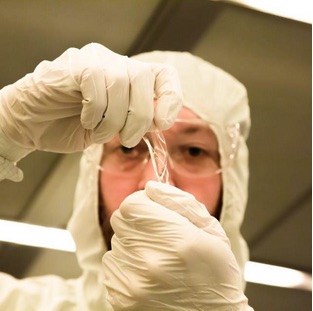 Researchers at an Australian university have developed stretchable, wearable sensors that could detect both harmful toxic gasses and dangerous UV radiation.
Researchers at an Australian university have developed stretchable, wearable sensors that could detect both harmful toxic gasses and dangerous UV radiation.
A team at the Royal Melbourne Institute of Technology developed the sensors, which are made from a thin layer of zinc oxide, a material found in sunscreen, engineered into a very thin but durable patch.
"This thin zinc oxide layer is engineered with a plate-like structure that we call micro-tectonics," Philipp Gutruf, lead author of the paper describing the sensors (recently published in the journal Small) said in a statement. "These plates can slide across each other bit like geological plates that form the earth’s crust allowing for high sensitivity and the ability to bend and flex the devices."
The sensors could detect toxic gasses like nitrogen dioxide and hydrogen, which could be useful for protecting workers in hazardous conditions, or for helping consumers keep a look out for pollution.
"Hydrogen leaks can lead to explosions as happened with the Hindenburg disaster and nitrogen dioxide is a major contributor to smog,” project leader Dr Madhu Bhaskaran said in a statement. “The ability to monitor such gases in production facilities and coal-fired power stations gives vital early warning of explosions, while the ability to sense nitrogen dioxide allows for a constant monitoring of pollution levels in crowded cities.”
But the most compelling use case from a consumer perspective is detecting UV radiation, which could be built into a consumer wearable that could alert users when they spend too much time in the sun and need to reapply sunscreen or move inside. The technology is cheap as well as durable, so researchers are bullish about potentially mass producing it.
Sun protection has been a fairly unexplored area in mobile health so far. In January of this year, two studies were published about an app called Solar Cell, which offers advice on sun protection, alerts to apply sunscreen, reapply sunscreen, and get out of the sun, hourly UV Index, vitamin D production based on the forecast UV Index, and the phone’s time and location.
In one study, participants who were using the app stayed in the shade more than those in the control group, but people in the treatment group used sunscreen less than those the control group. There was no significant difference in number of sunburns in the past three months between the group using apps and the group that wasn’t.
In another study, researchers found that participants in the intervention group used wide-brimmed hats more at seven weeks than control participants and women using Solar Cell reported using all sun protection techniques combined more than men. Additionally, men and older individuals reported less use of sunscreen and hats.
At an event earlier this month, Apple just added UV exposure as a new tracking field to its HealthKit personal health data exchange.
















